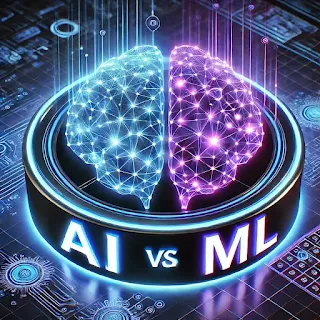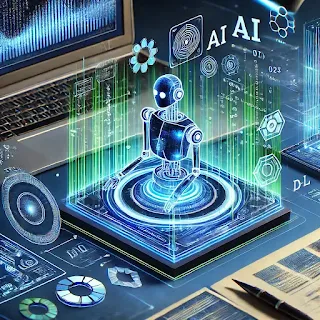AI vs. Machine Learning: The Key Differences You Must Know
- Get link
- X
- Other Apps
AI vs. Machine Learning: The Key
Differences You Must Know
Introduction
Are Artificial Intelligence (AI) and Machine Learning (ML) the same
thing? It’s a common question as these terms dominate tech discussions. While
related, they are not interchangeable. AI is the broader concept of machines
mimicking human intelligence, while ML is a subset that enables machines to
learn from data.
This article will demystify AI, ML, and Deep Learning (DL) in an engaging
way, showcasing real-world applications, key differences, and the latest
industry trends.
 |
| A visual representation of the difference between Artificial Intelligence and Machine Learning |
Key Takeaways
- AI is the big
picture: It aims to create machines that simulate human intelligence.
- ML is a subset
of AI: It enables machines to learn from data without explicit
programming.
- DL is a subset
of ML: It leverages neural networks for high-level data analysis.
- Real-world
impact: AI and ML are transforming industries, from healthcare to
entertainment.
What Is Artificial Intelligence (AI)?
AI is a field of computer science focused on building smart machines
capable of performing tasks that typically require human intelligence, such as:
- Speech
recognition (e.g., Siri, Alexa)
- Decision-making (e.g.,
self-driving cars)
- Recommendation
systems (e.g., Netflix, Amazon)
Types of AI
|
AI Type |
Description |
Example |
|
Narrow AI |
Designed for specific tasks |
Siri, spam filters |
|
General AI |
Can perform any
intellectual task |
Still theoretical |
|
Super AI |
Surpasses human intelligence |
Hypothetical |
AI encompasses ML and other approaches like rule-based systems and expert
systems.
What Is Machine Learning (ML)?
ML is a subset of AI that allows computers to learn from data without
being explicitly programmed. Instead of following fixed rules, ML algorithms
detect patterns in data and improve over time.
Real-Life Applications of ML
- Fraud detection (e.g., banks
identifying suspicious transactions)
- Medical
diagnosis (e.g., AI detecting diseases from X-rays)
- Personalized
recommendations (e.g., Spotify, YouTube)
 |
| Real-life examples of machine learning in everyday life |
Types of ML
|
Type |
Description |
Example |
|
Supervised Learning |
Learns from
labeled data |
Spam detection |
|
Unsupervised Learning |
Finds patterns in unlabeled data |
Customer segmentation |
|
Reinforcement Learning |
Learns through
trial and error |
AlphaGo beating
human players |
AI vs. ML: What’s the Difference?
|
Feature |
AI |
ML |
|
Definition |
The broad concept of intelligent
machines |
A subset of AI focused on data
learning |
|
Goal |
Mimic human
intelligence |
Improve from
experience |
|
Example |
Virtual assistants, self-driving
cars |
Spam filters, fraud detection |
In short, AI is the goal, while ML is a method to achieve it.
What Is Deep Learning (DL)?
Deep Learning (DL) is a subset of ML that uses neural networks to process
large amounts of data. Inspired by the human brain, DL is particularly powerful
in areas like image recognition and natural language processing (NLP).
|
Feature |
ML |
DL |
|
Feature Engineering |
|
Automatically extracts features |
|
Data Requirement |
Can work with
small data |
Needs massive
datasets |
|
Performance |
Good for structured data |
Excels in complex data like images,
text |
Example:
- ML approach: A programmer
defines key features to identify spam emails.
- DL approach: A deep neural
network learns patterns in spam emails without manual input.
Latest AI & ML Trends in 2025
The AI landscape is evolving rapidly. Here are some of the biggest
trends:
- Generative AI - AI creating
realistic images, text, and music (e.g., ChatGPT, DALL-E).
- Explainable AI - Making AI
decisions more transparent.
- Edge AI - Running AI
on local devices for faster processing.
- AI Ethics &
Regulations - Ensuring AI fairness and privacy.
 |
| Top AI and ML trends for 2025 |
Alt text: Future of AI and ML
Caption: The latest trends shaping the future of AI and Machine Learning.
Conclusion
AI, ML, and DL are reshaping industries and everyday life. While AI is
the grand vision, ML is a crucial tool within it, and DL takes ML to the next
level. Understanding these differences helps you grasp how modern technology is
evolving.
FAQ
1. Is all AI based on ML?
No. Some AI systems use rule-based logic or expert systems instead of ML.
2. Can ML exist without AI?
ML is a subset of AI, so it inherently belongs to the AI domain.
3. How does Deep Learning differ from
traditional ML?
DL uses neural networks to analyze data, whereas traditional ML relies on
manual feature extraction.
Further Reading & Resources
- Get link
- X
- Other Apps




Comments
Post a Comment